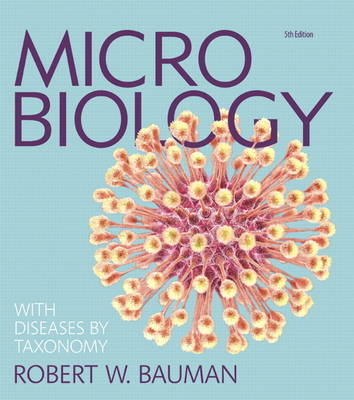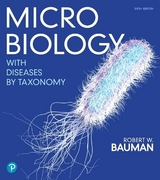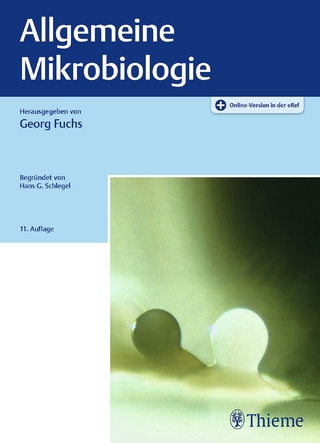
Microbiology with Diseases by Taxonomy
Pearson (Verlag)
978-0-13-401919-2 (ISBN)
- Titel erscheint in neuer Auflage
- Artikel merken
KEY TOPICS: A Brief History of Microbiology, The Chemistry of Microbiology, Cell Structure and Function, Microscopy, Staining, and Classification, Microbial Metabolism, Microbial Nutrition and Growth, Microbial Genetics, Recombinant DNA Technology, Controlling Microbial Growth in the Environment, Controlling Microbial Growth in the Body: Antimicrobial Drugs, Characterizing and Classifying Prokaryotes, Characterizing and Classifying Eukaryotes, Characterizing and Classifying Viruses, Viroids, and Prions, Infection, Infectious Diseases, and Epidemiology, Innate Immunity, Adaptive Immunity, Immunization and Immune Testing, Immune Disorders, Pathogenic Gram-Positive Bacteria, Pathogenic Gram-Negative Cocci and Bacilli, Rickettsias, Chlamydias, Spirochetes, and Vibrios, Pathogenic Fungi, Parasitic Protozoa, Helminths, and Arthropod Vectors, Pathogenic DNA Viruses, Pathogenic RNA Viruses, Applied and Environmental Microbiology
MARKET: For anyone interested in Microbiology.
Robert W. Bauman holds a Ph.D. in Biology from Stanford University, an M.A. in Botany from the University of Texas at Austin, and a B.A. in Biology from the University of Texas at Austin. He is a tenured, full professor of biology in the Department of Mathematics, Sciences, and Engineering at Amarillo College in Amarillo, Texas, where he previously served as chairman of the Department of Biological Sciences. He has been teaching microbiology, botany, and human anatomy and physiology since 1988. In 2004, the students of Amarillo College selected Dr. Bauman as the recipient of the John. F. Mead Faculty Excellence Award. His research interests have included the morphology, ecology, and culturing of freshwater algae and photosynthetic protists, the cell biology of marine algae (particularly the deposition of cell walls and intercellular communication), and environmentally triggered chromogenesis in butterflies. His dissertation research at Stanford was on intercellular communication and cell growth in red algae at the Hopkins Marine Station. Robert Bauman is the author of another microbiology textbook at Pearson, Microbiology with Diseases by Body System, 3/e (copyright 2012). He is an active member of the American Society of Microbiology (ASM), serving as chairman of the Education Section from 2012-2013, and of the Texas Community College Teachers Association (TCCTA). In 2007, Dr. Bauman initiated an endowment at ASM to fund an annual travel grant for new instructors of microbiology to participate in the ASM Conference for Undergraduate Educators. Contributor TODD P. PRIMM is an associate professor at Sam Houston State University, where he teaches pre-nursing microbiology. He also serves as Director of the Professional and Academic Center for Excellence, which focuses on improving teaching and learning on campus. In 2010, he was Distinguished Alumnus of the Graduate School of Biomedical Sciences of Baylor College of Medicine, where he earned a Ph.D. in Biochemistry in 1997. He received a B.S. from Texas A&M University in 1992. He is very active in the American Society for Microbiology and received the Texas Branch 2015 Faculty Teaching Award. He was chair of the organizing committee for the 2013 ASM Conference for Undergraduate Educators, participated in the 2012 Research Residency of the ASM/NSF Biology Scholars Program, and currently serves on the editorial board for the Journal of Microbiology and Biology Education. He is also an affiliate staff member with the international organization Cru. He loves teaching and mentoring students and spending time with his wonderful wife of 23 years and four children.
1. A Brief History of Microbiology
2. The Chemistry of Microbiology
3. Cell Structure and Function
4. Microscopy, Staining, and Classification
5. Microbial Metabolism
6. Microbial Nutrition and Growth
7. Microbial Genetics
8. Recombinant DNA Technology
9. Controlling Microbial Growth in the Environment
10. Controlling Microbial Growth in the Body: Antimicrobial Drugs
11. Characterizing and Classifying Prokaryotes
12. Characterizing and Classifying Eukaryotes
13. Characterizing and Classifying Viruses, Viroids, and Prions
14. Infection, Infectious Diseases, and Epidemiology
15. Innate Immunity
16. Adaptive Immunity
17. Immunization and Immune Testing
18. Immune Disorders
19. Pathogenic Gram-Positive Bacteria
20. Pathogenic Gram-Negative Cocci and Bacilli
21. Rickettsias, Chlamydias, Spirochetes, and Vibrios
22. Pathogenic Fungi
23. Parasitic Protozoa, Helminths, and Arthropod Vectors
24. Pathogenic DNA Viruses
25. Pathogenic RNA Viruses
26. Applied and Environmental Microbiology
| Erscheinungsdatum | 02.09.2016 |
|---|---|
| Sprache | englisch |
| Maße | 249 x 279 mm |
| Gewicht | 2109 g |
| Themenwelt | Naturwissenschaften ► Biologie ► Mikrobiologie / Immunologie |
| ISBN-10 | 0-13-401919-9 / 0134019199 |
| ISBN-13 | 978-0-13-401919-2 / 9780134019192 |
| Zustand | Neuware |
| Informationen gemäß Produktsicherheitsverordnung (GPSR) | |
| Haben Sie eine Frage zum Produkt? |
aus dem Bereich



